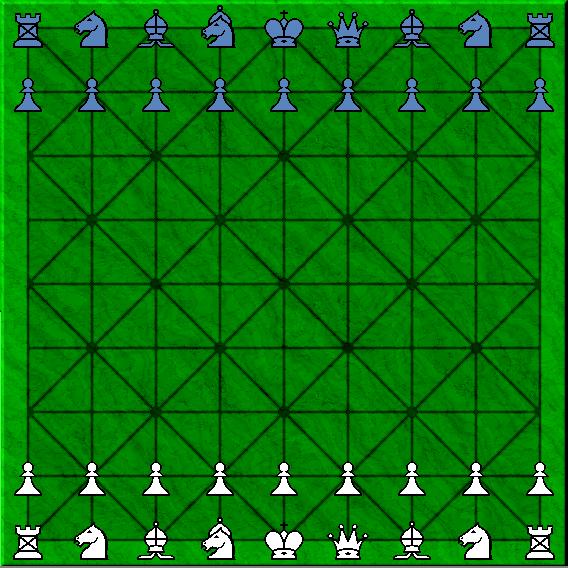Chesquerque
Introduction
Chesquerque is a Chess variant designed by George Dekle Sr. in 1986. It's played on a the points of a quadruple Alquerque board, whose limited connectivity gives the game a fairly different feel than FIDE Chess.Board and Setup

The board is 9x9 with only every other square (a1, a3, a5, a7, a9, b2, b4, etc.) having diagonal connectivity. White pieces occupy the first row, and are ordered: Rook, Knight, Bishop, Archbishop, King, Queen, Bishop, Knight, Rook. White Pawns occupy the second row. Black pieces occpy the ninth row in the same order as the White pieces, and Black pawns occupy the eighth row.
General Rules
The rules of Chesquerque are identical to those of FIDE Chess, except where noted otherwise below.Movement of Pieces
The most important difference in movement from Chess played on a regular chess board is that half of the points on the board have no diagonal connecting lines. Such points can not be entered or exited by a diagonal move.Kings, Queens and Knights moves as they do in FIDE Chess, with the additional constraints provided by the board. Additionally, castling King-side is the same as castling Queen-side.
The Archbishop slides diagonally (like a FIDE Bishop) or leaps like a Knight. The Archbishop is a well known variant piece, and often called the Cardinal or the Princess.
The Rook, in addition to sliding up, down, left or right, may take a single step diagonally. This is the same piece as the Dragon-King from Shogi, where it is the promoted form of the Rook.
The Bishop, in addition to sliding diagonally, may take a single step left, right, up or down. This is the same piece as the Dragon-Horse from Shogi, where it is the promoted form of the Bishop.
The Pawn moves and captures one step forward or (when possible) diagonally forward. It captures the same way it moves. On its first move a Pawn may make a non-capturing double step in any of the forward directions. When so doing, it may be captured en passant by an opposing Pawn sitting on rank it just moved to, if the double-stepping Pawn move through a square attacked by the opposing Pawn. In that case the opposing Pawn moves to that attacked square and the double-stepping Pawn is removed. This capture may only be done the turn immediately after the double-step. En Passant capture is optional. Pawns promote to Queen, Archbishop, Rook, Bishop or Knight upon reaching the ninth rank.
Notes
All pieces other than Knights are stronger when sitting on a diagonally connected point, however, they are also more vulnerable to attack.It is possible that the Archbishop is supposed to combine the Chesquerque Bishop with the Knight rather than the FIDE Bishop and the Knight. This would make it a more valuable piece, closer in value to the Queen.
Sources
This information is based on the description in Pritchard's Encyclopedia of Chess Variants.Computer Play
There is an implementation of Chesquerque for Zillions of Games. You can download it here:
Both versions of the Archbishop are available.
Written by Peter Aronson.
WWW page created: July 24th, 2004.
